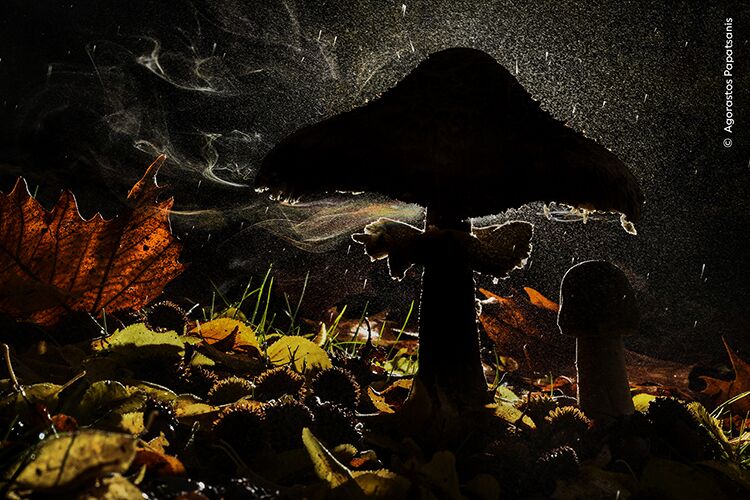
The winners of the Wildlife Photographer of the Year 2023, a showcase of the rich diversity of life on Earth
French underwater photographer and marine biologist Laurent Ballesta has been declared Wildlife Photographer of the Year 2023 for his otherworldly image of a tri-spine horseshoe crab accompanied by a trio of golden trevallies.
The tri-spine horseshoe crab has survived for more than 100 million years, but now faces habitat destruction and overfishing for food and for its blue blood, used in the development of vaccines. But, in the protected waters of Pangatalan Island in the Philippines, there is hope for its survival.

The ancient mariner by Laurent Ballesta, Wildlife Photographer of the Year 2023
Category: Portfolio Award
Marine biologist and photographer Laurent Ballesta has dedicated his life to exploring the oceans and revealing their wonder through art. He has led a series of major expeditions, all involving scientific mysteries and diving challenges, and all resulting in unprecedented images. In this one, Ballesta captures a ‘golden horseshoe’ – a tri-spine horseshoe crab – as it moves slowly over the mud. A trio of juvenile golden trevallies are poised to dart down for edible morsels ploughed up by its passage.
Chair of the jury and editor, Kathy Moran says, ‘To see a horseshoe crab so vibrantly alive in its natural habitat, in such a hauntingly beautiful way, was astonishing. We are looking at an ancient species, highly endangered, and also critical to human health. This photo is luminescent.’
Laurent is only the second photographer in the competition’s fifty-nine-year history to be awarded the Grand Title award twice. He was first awarded Wildlife Photographer of the Year in 2021 for his intriguing image of camouflage groupers exiting a milky cloud of eggs and sperm in Fakarava, French Polynesia.

Owl’s road house by Carmel Bechler, Young Wildlife Photographer of the Year 2023
Category: 15-17 Years
Seventeen-year-old Carmel Bechler from Israel was awarded Young Wildlife Photographer of the Year 2023 for his ‘Owls’ road house’, a dynamic frame of barn owls in an abandoned roadside building. Using the family car as hide, Carmel made the most of natural light and long exposure times to capture the light trails of passing traffic.
‘Whilst inspiring absolute awe and wonder, this year’s winning images present compelling evidence of our impact on nature – both positive and negative,’ says Doug Gurr, Director of the Natural History Museum. ‘Global promises must shift to action to turn the tide on nature’s decline.’
The Wildlife Photographer of the Year is developed and produced by the Natural History Museum, London. The winning images, which were selected from 49,957 entries from 95 countries, were revealed at an awards ceremony in South Kensington on 10 October and will be exhibited at the Natural History Museum from Friday 13 October 2023 to Sunday 30 June 2024.
See a selection of other category winners below.

Life on the edge by Amit Eshel
Category: Animals in their Environment
After hiking to a vantage point on the clifftop, Amit slowly crept closer, using a wide-angle lens to set the action of two clashing Nubian ibex against the dramatic backdrop. The battle lasted for about 15 minutes before one male surrendered, and the pair parted without serious injury. In the run-up to the mating season, part of the males’ coat darkens, and their neck muscles thicken. Rivals will raise up on their hind legs and ram their heads together. Their horns sometimes break as they collide.

Face of the forest by Vishnu Gopal
Category: Animal Portraits
Finding hoofprints on a forest track near his campsite, Vishnu waited nearby. An hour later, the tapir appeared. Using a long exposure and torchlight to capture texture and movement, Vishnu framed the tapir’s side-turned head as it emerged from the forest. Lowland tapirs rely on the forest for their diet of fruit and other vegetation and in turn the tapirs act as seed dispersers. This important relationship is threatened by habitat loss, illegal hunting, and traffic collisions.

Whales making waves by Bertie Gregory
Category: Behaviour: Mammals
Bertie took two month-long expeditions searching for orcas. ‘We spent every waking minute on the roof of the boat, scanning,’ he says. After battling high winds and freezing conditions, he captured this remarkable behaviour with his drone. These orcas belong to a group that specialises in hunting seals by charging towards the ice, creating a wave that washes the seal into the water. With rising temperatures melting ice floes, seals are spending more time on land, and the behaviour of ‘wave washing’ may disappear.

Birds of the midnight sun by Knut-Sverre Horn
Category: Urban Wildlife
From his vantage point inside an abandoned fish-processing factory, Knut-Sverre kept watch on the black-legged kittiwakes tending to their chicks on the windowsill. As midnight approached, the low summer sun struck the north-facing window, sharpening the birds’ silhouettes and giving him the image that he wanted. Kittiwakes naturally nest on the narrow ledges of high, steep coastal cliffs. Recently numbers have plummeted, and some have headed for urban areas due to shortages of food caused by warming oceans and pollution.
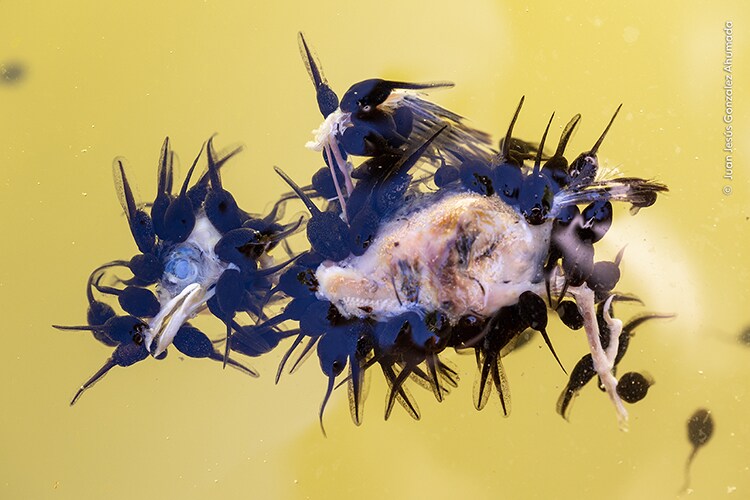
The tadpole banquet by Juan Jesús Gonzalez Ahumada
Category: Behaviour: Amphibians and Reptiles
The drama unfolded near Juan’s home when a newly fledged sparrow launched itself from a nest on his neighbour’s roof and fell into a nearby pond, where it drowned. Juan had to pick his moment to show the tadpole formation and the sparrow’s eye. Common toad tadpoles have varied diets consisting of algae, vegetation, and tiny swimming invertebrates. As they grow larger, they become more carnivorous so when a banquet like this arrives, they take full advantage.
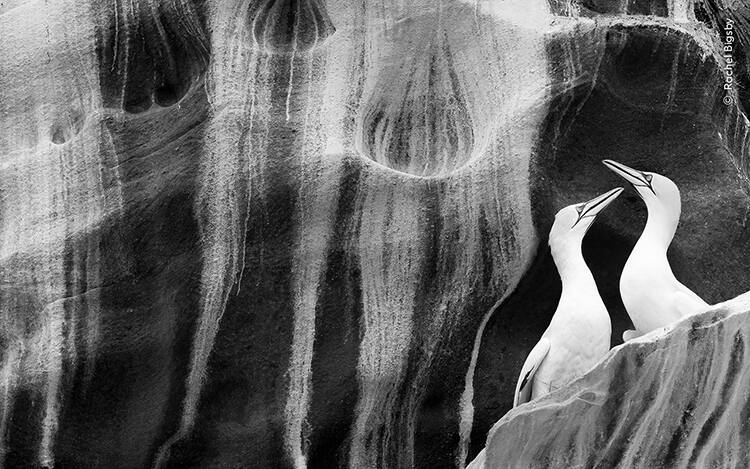
The art of courtship by Rachel Bigsby
Category: Natural Artistry
From her boat in turbulent sea swell, Rachel realised that achieving her vision of showcasing gannets set against the towering cliffs would be tricky. But as the boat aligned with the rocks, she spotted this pair ‘isolated on a lower ledge, intertwining their necks and framed by streaks of guano’. Each summer the Isle of Noss hosts more than 22,000 northern gannets, which return to breed on the ledges carved by the elements. This species was hardest hit by the 2022 avian flu outbreak.
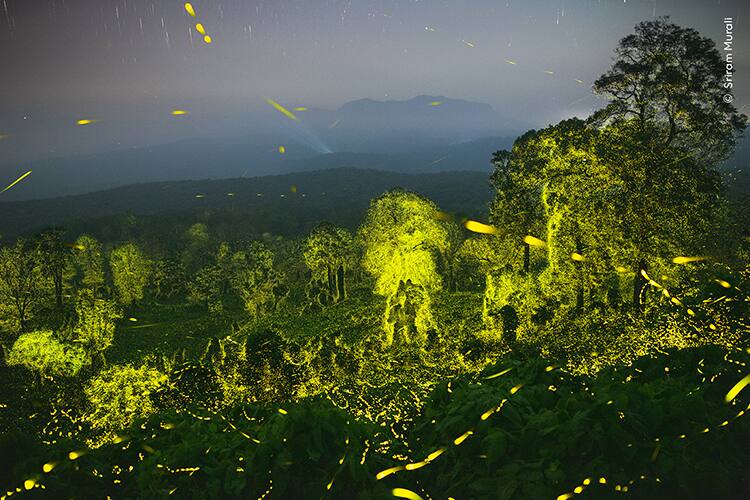
Lights fantastic by Sriram Murali
Category: Behaviour: Invertebrates
Sriram combined fifty 19-second exposures to show the firefly flashes produced over 16 minutes in the forests near his hometown. The firefly flashes start at twilight, with just a few, before the frequency increases and they pulse in unison like a wave across the forest. Fireflies, which are in fact beetles, are famous for attracting mates using bioluminescence. Darkness is a necessary ingredient in the success of this process. Light pollution affects many nocturnal creatures, but fireflies are especially susceptible.
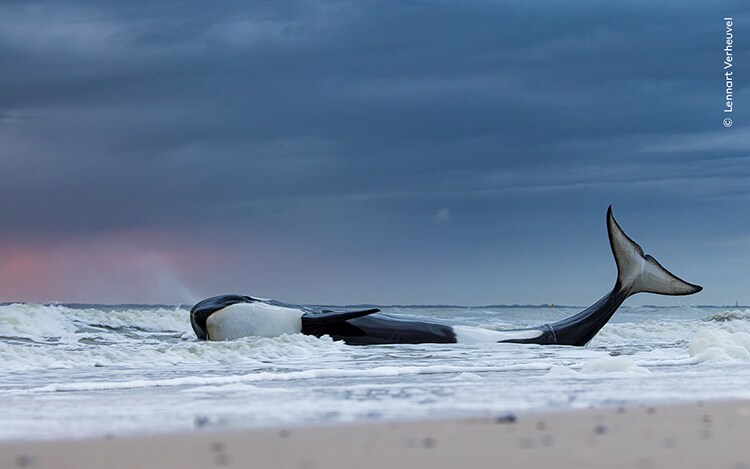
Last gasp by Lennart Verheuvel
Category: Oceans: The Bigger Picture
Lennart Verheuvel shows the final moments of a beached orca. Lying on its side in the surf, this orca had only a short time left to live. Initially rescued, it soon was stranded again on the beach and died. A study later revealed that not only was it severely malnourished, it was also extremely sick. Research shows that orcas in European waters have the world’s highest concentrations of polychlorinated biphenyls. These banned chemicals can persist for many years in marine food webs, weakening immune systems and reducing breeding success in whales, porpoises and dolphins.




